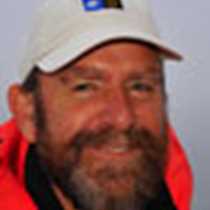Loen, Kjenndal, Nordfjord
The day started with cloud and drizzle at Loen, but ended with a fine sunset off the western coast of Norway. By breakfast we were deep into Nordfjord, at 100km (62miles) the third longest fjord in Norway and certainly one of the most beautiful. Our trusty Zodiacs ferried us ashore to where three comfortable coaches waited; in no time we were following the precipitous shores of Loenvatnet, a turquoise-blue glacial lake just inland from the town. We paused at a roadside memorial and looked across at the soaring black cliff of Ramnefjellet, the Raven’s Mountain, site of a terrible double tragedy in 1905, cruelly repeated in 1936.A huge rockfall from this mountain toppled into the lake below and created a tidal wave which engulfed the hamlets of Kjern and Loen, killing 61 people. Though they believed it could never happen again, a second rockfall 31 years later killed a further 74 living in the lakeside farms.
We continued into the narrowing valley, sheer cliffs soaring into the mist on either side, to reach Kjenndal Glacier, one of the icy limbs of Jostedalsbreen, the largest glacier in mainland Europe. We walked a boulder-strewn path to its blue snout, and could see from the bare flanks of the mountain either side that it is shrinking rapidly. It has been retreating at 80m a year since 1997, in common with all the glaciers of northern Europe. It was a pleasure to retreat ourselves to a placid lakeside restaurant, and console ourselves with coffee and Norwegian waffles, daubed by the more artistic among us with dollops of sour cream and raspberry jam. Back in Loen we stopped to look at the wooden church and its ancient celtic cross. From here we walked back down to the ship between strawberry fields and apple orchards.
After falling like Vikings on the buffet lunch, we gathered our breath for a final adventure at sea: just off Rugsund Island, we launched our Zodiacs and set off on a dramatic shortcut past Sorøya, for a planned rendezvous with the ship on the other side. The barren rocks of the island were cloaked in heather, with scattered birch and rowan. We looked at a salmon farm on the shore, where muscular silver fish were leaping inside their pens. Threading a narrow sound, we passed old boathouses and typical turf-roofed houses, but star sighting was a startled otter slipping into the black waters. We reached our rendezvous in time to see ,I>Endeavour steaming in towards us, looking like a toy ship beneath the huge bulk of Hornelneset. Still in Zodiac convoy we motored gingerly under the overhanging rock face and almost fell over backwards trying to look up to the summit, which at 2,900’ is the highest sea cliff in Europe. Mindful of the previous history of dramatic rockfalls, we beat a hasty retreat back to the ship where a splendid Filipino supper and the finest sunset of the voyage awaited us.
The day started with cloud and drizzle at Loen, but ended with a fine sunset off the western coast of Norway. By breakfast we were deep into Nordfjord, at 100km (62miles) the third longest fjord in Norway and certainly one of the most beautiful. Our trusty Zodiacs ferried us ashore to where three comfortable coaches waited; in no time we were following the precipitous shores of Loenvatnet, a turquoise-blue glacial lake just inland from the town. We paused at a roadside memorial and looked across at the soaring black cliff of Ramnefjellet, the Raven’s Mountain, site of a terrible double tragedy in 1905, cruelly repeated in 1936.A huge rockfall from this mountain toppled into the lake below and created a tidal wave which engulfed the hamlets of Kjern and Loen, killing 61 people. Though they believed it could never happen again, a second rockfall 31 years later killed a further 74 living in the lakeside farms.
We continued into the narrowing valley, sheer cliffs soaring into the mist on either side, to reach Kjenndal Glacier, one of the icy limbs of Jostedalsbreen, the largest glacier in mainland Europe. We walked a boulder-strewn path to its blue snout, and could see from the bare flanks of the mountain either side that it is shrinking rapidly. It has been retreating at 80m a year since 1997, in common with all the glaciers of northern Europe. It was a pleasure to retreat ourselves to a placid lakeside restaurant, and console ourselves with coffee and Norwegian waffles, daubed by the more artistic among us with dollops of sour cream and raspberry jam. Back in Loen we stopped to look at the wooden church and its ancient celtic cross. From here we walked back down to the ship between strawberry fields and apple orchards.
After falling like Vikings on the buffet lunch, we gathered our breath for a final adventure at sea: just off Rugsund Island, we launched our Zodiacs and set off on a dramatic shortcut past Sorøya, for a planned rendezvous with the ship on the other side. The barren rocks of the island were cloaked in heather, with scattered birch and rowan. We looked at a salmon farm on the shore, where muscular silver fish were leaping inside their pens. Threading a narrow sound, we passed old boathouses and typical turf-roofed houses, but star sighting was a startled otter slipping into the black waters. We reached our rendezvous in time to see ,I>Endeavour steaming in towards us, looking like a toy ship beneath the huge bulk of Hornelneset. Still in Zodiac convoy we motored gingerly under the overhanging rock face and almost fell over backwards trying to look up to the summit, which at 2,900’ is the highest sea cliff in Europe. Mindful of the previous history of dramatic rockfalls, we beat a hasty retreat back to the ship where a splendid Filipino supper and the finest sunset of the voyage awaited us.




